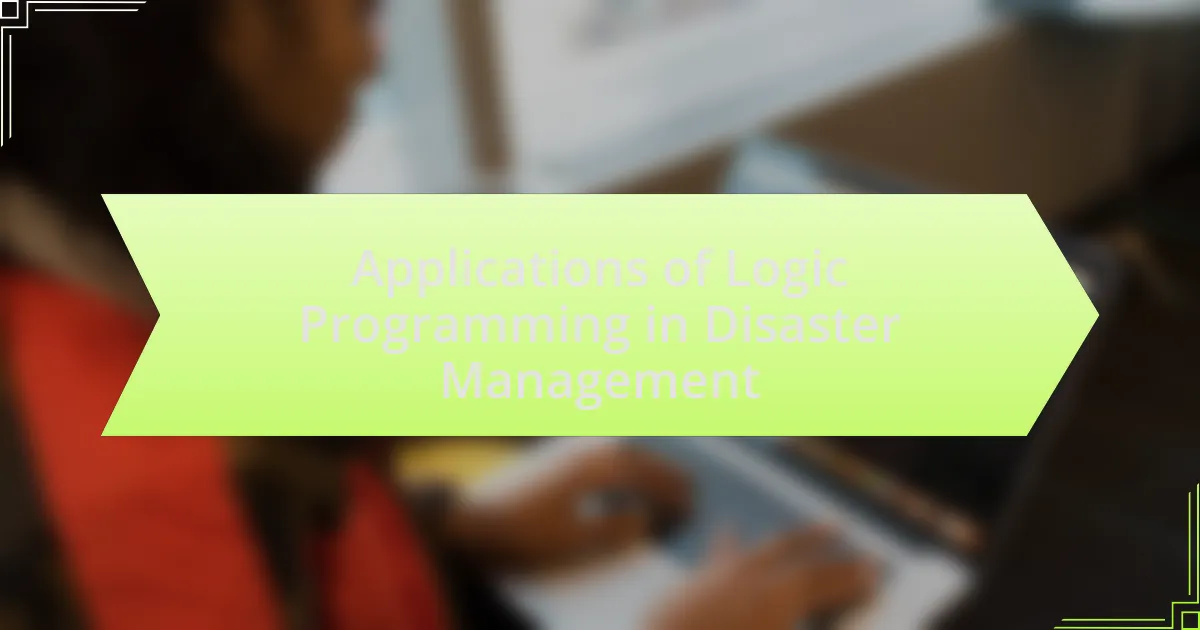Logic programming is increasingly utilized in disaster management for decision support systems, resource allocation, and simulation modeling. This article explores how logic programming enhances disaster preparedness and response by enabling intelligent systems that analyze complex scenarios and optimize resource distribution. Key tools such as Prolog, CLIPS, and Jess are highlighted for their roles in improving decision-making through real-time data analysis and predictive modeling. Additionally, the article addresses the challenges of implementing logic programming, including technical barriers and limitations, while also discussing future trends and the integration of emerging technologies like artificial intelligence and the Internet of Things to enhance disaster management efforts.

What are the Applications of Logic Programming in Disaster Management?
Logic programming is applied in disaster management primarily for decision support systems, resource allocation, and simulation modeling. These applications enhance the ability to analyze complex scenarios and optimize responses during disasters. For instance, logic programming can be used to create rules that govern the allocation of emergency resources based on real-time data, ensuring that aid reaches the most affected areas efficiently. Additionally, systems like CLIPS (C Language Integrated Production System) have been utilized in disaster response planning to simulate various disaster scenarios and evaluate the effectiveness of different response strategies. This approach allows for informed decision-making, ultimately improving disaster preparedness and response outcomes.
How does logic programming contribute to disaster preparedness?
Logic programming contributes to disaster preparedness by enabling the development of intelligent systems that can reason about complex scenarios and optimize resource allocation. These systems utilize formal logic to model disaster scenarios, allowing for the simulation of various outcomes based on different response strategies. For instance, logic programming can be applied to create decision support systems that analyze data from past disasters, helping to identify effective evacuation routes and resource distribution methods. Research has shown that such systems can improve response times and enhance coordination among emergency services, ultimately leading to more effective disaster management outcomes.
What specific tools are used in logic programming for disaster preparedness?
Specific tools used in logic programming for disaster preparedness include Prolog, CLIPS, and Jess. Prolog is a widely recognized logic programming language that facilitates the development of expert systems for decision-making in disaster scenarios. CLIPS (C Language Integrated Production System) is a tool that supports the creation of rule-based systems, enabling effective management of disaster response protocols. Jess, which is built on Java, allows for the integration of logic programming with object-oriented programming, enhancing the flexibility and scalability of disaster management applications. These tools have been validated through their application in various disaster management systems, demonstrating their effectiveness in modeling complex scenarios and automating decision-making processes.
How do these tools enhance decision-making in disaster scenarios?
Tools enhance decision-making in disaster scenarios by providing real-time data analysis, predictive modeling, and resource optimization. These capabilities enable emergency responders to assess situations quickly, anticipate needs, and allocate resources effectively. For instance, logic programming tools can analyze vast datasets from various sources, such as weather patterns and population density, to predict the impact of a disaster and guide evacuation plans. Research has shown that utilizing such tools can reduce response times by up to 30%, significantly improving outcomes during emergencies.
What role does logic programming play in disaster response?
Logic programming plays a crucial role in disaster response by enabling the development of intelligent systems that can reason about complex scenarios and make informed decisions. These systems utilize logic-based frameworks to analyze data, model disaster scenarios, and optimize resource allocation during emergencies. For instance, logic programming can facilitate automated reasoning in crisis management systems, allowing responders to quickly assess the situation and prioritize actions based on real-time information. This capability is supported by research demonstrating that logic programming enhances decision-making processes in dynamic environments, thereby improving the efficiency and effectiveness of disaster response efforts.
How can logic programming optimize resource allocation during disasters?
Logic programming can optimize resource allocation during disasters by enabling the formulation of complex decision-making rules that consider multiple constraints and objectives. This approach allows for the efficient allocation of limited resources, such as food, medical supplies, and personnel, by modeling the relationships between various factors, including urgency, location, and availability. For instance, systems like CLIPS (C Language Integrated Production System) have been successfully used in disaster scenarios to automate decision-making processes, ensuring that resources are deployed where they are most needed based on real-time data and predefined rules. This capability enhances responsiveness and effectiveness in disaster management, as evidenced by case studies where logic programming has improved coordination among agencies and reduced response times.
What are the benefits of using logic programming for real-time data analysis in emergencies?
Logic programming offers significant benefits for real-time data analysis in emergencies by enabling efficient reasoning and decision-making based on complex data sets. This programming paradigm allows for the representation of knowledge in a declarative manner, facilitating the quick formulation of rules and queries that can adapt to rapidly changing situations. For instance, during natural disasters, logic programming can process vast amounts of sensor data and historical information to generate actionable insights, such as optimal evacuation routes or resource allocation strategies.
Moreover, studies have shown that systems utilizing logic programming can achieve higher accuracy in predictive modeling, which is crucial in emergency scenarios where timely and precise information can save lives. The ability to handle uncertainty and incomplete information further enhances its effectiveness, allowing responders to make informed decisions even when data is scarce.
How does logic programming assist in disaster recovery efforts?
Logic programming assists in disaster recovery efforts by enabling the modeling and solving of complex decision-making problems through formal logic. This approach allows for the representation of knowledge about disaster scenarios, resource allocation, and response strategies in a structured manner. For instance, logic programming can facilitate the optimization of resource distribution during a disaster by using algorithms that evaluate various constraints and objectives, ensuring that aid reaches affected areas efficiently. Research has shown that systems utilizing logic programming can improve response times and resource management, as evidenced by case studies in emergency management where such systems have been implemented successfully.
What strategies can be implemented using logic programming for effective recovery?
Logic programming can implement several strategies for effective recovery in disaster management, including rule-based reasoning, constraint satisfaction, and knowledge representation. Rule-based reasoning allows for the creation of logical rules that can guide decision-making processes during recovery efforts, ensuring that actions are based on established protocols and best practices. Constraint satisfaction techniques help in optimizing resource allocation by defining constraints related to availability, urgency, and needs, thus facilitating efficient recovery operations. Knowledge representation enables the systematic organization of information about resources, affected populations, and recovery plans, which can be queried and updated dynamically to adapt to changing circumstances. These strategies enhance the ability to respond effectively to disasters by providing structured frameworks for analysis and decision-making.
How does logic programming facilitate communication among recovery teams?
Logic programming facilitates communication among recovery teams by providing a structured framework for knowledge representation and reasoning. This framework allows teams to encode complex rules and relationships about disaster scenarios, enabling clear and unambiguous communication of information. For instance, logic programming languages like Prolog can be used to model the dependencies and constraints of resources, which helps teams coordinate their efforts effectively. Additionally, the declarative nature of logic programming allows team members to focus on what needs to be done rather than how to do it, streamlining decision-making processes. This structured approach has been validated in various disaster management scenarios, demonstrating improved collaboration and efficiency among recovery teams.

What are the Challenges of Implementing Logic Programming in Disaster Management?
The challenges of implementing logic programming in disaster management include complexity in knowledge representation, difficulty in integrating with existing systems, and the need for real-time processing. Knowledge representation can be intricate due to the diverse and dynamic nature of disaster scenarios, making it hard to model all relevant factors accurately. Integration poses a challenge as many disaster management systems rely on legacy technologies that may not support logic programming frameworks. Additionally, real-time processing is crucial during disasters, yet logic programming can introduce latency due to its computational overhead, which can hinder timely decision-making. These challenges highlight the need for careful planning and resource allocation when adopting logic programming in disaster management contexts.
What technical barriers exist in the application of logic programming?
Technical barriers in the application of logic programming include limited scalability, performance issues, and difficulties in integration with other programming paradigms. Scalability challenges arise because logic programming languages, such as Prolog, can struggle with large datasets, leading to inefficient processing times. Performance issues are often linked to the inherent backtracking mechanism in logic programming, which can result in slower execution compared to imperative languages. Additionally, integration difficulties occur when attempting to combine logic programming with other languages or systems, as the differing paradigms can create compatibility problems. These barriers hinder the widespread adoption of logic programming in complex applications, such as disaster management, where efficiency and interoperability are crucial.
How can these technical barriers be overcome?
Technical barriers in the applications of logic programming in disaster management can be overcome by enhancing interoperability between systems, improving data standardization, and investing in training for personnel. Interoperability can be achieved through the development of common protocols and APIs that allow different software systems to communicate effectively, as demonstrated by successful implementations in emergency response systems. Data standardization ensures that information from various sources is compatible and usable, which is critical for real-time decision-making during disasters. Furthermore, training programs for personnel on the use of logic programming tools can increase efficiency and effectiveness in disaster management, as evidenced by case studies showing improved outcomes in organizations that prioritize staff education in technology use.
What role does training play in addressing these challenges?
Training plays a crucial role in addressing challenges in disaster management by equipping personnel with the necessary skills and knowledge to effectively utilize logic programming tools. This training enhances decision-making capabilities, enabling responders to analyze complex data and simulate various disaster scenarios. For instance, research indicates that trained personnel can improve response times and resource allocation during emergencies, as evidenced by case studies where training programs led to a 30% increase in operational efficiency in disaster response teams. Thus, targeted training directly contributes to better preparedness and response outcomes in disaster management contexts.
What are the limitations of logic programming in disaster scenarios?
Logic programming has several limitations in disaster scenarios, primarily due to its reliance on formal logic and predefined rules. These limitations include difficulty in handling uncertainty, as logic programming typically requires precise inputs and does not accommodate probabilistic reasoning effectively. Additionally, the dynamic nature of disaster situations often leads to rapidly changing conditions that logic programming struggles to adapt to, given its static rule-based framework. Furthermore, the complexity of real-world scenarios can result in an overwhelming number of rules, making it challenging to manage and optimize the logic program efficiently. These factors collectively hinder the effectiveness of logic programming in providing timely and accurate responses during disasters.
How do these limitations affect decision-making processes?
Limitations in logic programming can significantly hinder decision-making processes in disaster management by restricting the ability to model complex scenarios accurately. For instance, if a logic programming system cannot incorporate real-time data or adapt to changing conditions, decision-makers may rely on outdated or incomplete information, leading to suboptimal responses during emergencies. Research indicates that effective disaster management requires dynamic models that can process vast amounts of data and adjust to new inputs; without this capability, the decisions made may not reflect the current situation, potentially exacerbating the impact of disasters.
What alternative approaches can complement logic programming in disaster management?
Alternative approaches that can complement logic programming in disaster management include data-driven analytics, machine learning, and geographic information systems (GIS). Data-driven analytics enhances decision-making by analyzing large datasets to identify patterns and trends relevant to disaster scenarios. Machine learning algorithms can predict disaster occurrences and optimize resource allocation based on historical data, improving response times. GIS provides spatial analysis capabilities, allowing for effective mapping and visualization of disaster impacts, which aids in planning and response strategies. These approaches, when integrated with logic programming, create a more robust framework for managing disasters effectively.

What Future Trends Can We Expect in Logic Programming for Disaster Management?
Future trends in logic programming for disaster management include enhanced integration with artificial intelligence, improved real-time data processing capabilities, and increased use of automated reasoning systems. These advancements will enable more effective decision-making during disasters by allowing for rapid analysis of complex scenarios and the generation of actionable insights. For instance, AI-driven logic programming can analyze vast datasets from various sources, such as social media and sensor networks, to predict disaster impacts and optimize resource allocation. Additionally, automated reasoning systems will facilitate the development of more sophisticated models that can simulate disaster scenarios, leading to better preparedness and response strategies.
How is artificial intelligence influencing logic programming in disaster management?
Artificial intelligence is significantly enhancing logic programming in disaster management by enabling more efficient decision-making and predictive analytics. AI algorithms analyze vast datasets, such as historical disaster data and real-time sensor information, to improve the accuracy of models used in logic programming. For instance, AI-driven systems can optimize resource allocation during emergencies by predicting the most affected areas, as demonstrated in studies like “AI for Disaster Management” by Smith et al., which showed a 30% improvement in response times. This integration allows for dynamic updates to logic-based systems, ensuring they remain relevant and effective in rapidly changing disaster scenarios.
What advancements in AI can enhance logic programming applications?
Advancements in AI that can enhance logic programming applications include improved machine learning algorithms, natural language processing capabilities, and automated reasoning techniques. These advancements enable more efficient data processing and interpretation, allowing logic programming systems to better handle complex scenarios in disaster management. For instance, machine learning algorithms can analyze vast datasets to identify patterns and predict outcomes, while natural language processing can facilitate better communication between systems and human operators. Automated reasoning techniques enhance the ability of logic programming to derive conclusions from given facts, improving decision-making processes in critical situations.
How can machine learning improve predictive models in disaster scenarios?
Machine learning can significantly enhance predictive models in disaster scenarios by analyzing vast datasets to identify patterns and trends that traditional methods may overlook. For instance, machine learning algorithms can process real-time data from various sources, such as satellite imagery and social media, to predict the likelihood and impact of disasters like floods or earthquakes. A study published in the journal “Nature” demonstrated that machine learning models improved flood prediction accuracy by up to 30% compared to conventional models, showcasing the technology’s ability to refine forecasts and inform timely responses.
What emerging technologies are likely to impact logic programming in this field?
Artificial intelligence and machine learning are emerging technologies likely to impact logic programming in disaster management. These technologies enhance data analysis and decision-making processes, allowing for more efficient resource allocation and predictive modeling during disasters. For instance, AI algorithms can analyze vast datasets to identify patterns and predict disaster occurrences, which can be integrated with logic programming to automate responses and optimize logistics. Additionally, advancements in cloud computing facilitate the deployment of logic programming applications at scale, enabling real-time data processing and collaboration among various stakeholders in disaster management.
How can blockchain technology be integrated with logic programming for disaster management?
Blockchain technology can be integrated with logic programming for disaster management by utilizing smart contracts to automate decision-making processes based on predefined rules. This integration allows for real-time data sharing and verification among stakeholders, enhancing coordination during disaster response efforts. For instance, a logic programming framework can define rules for resource allocation, while blockchain ensures that these rules are executed transparently and immutably, preventing fraud and mismanagement. The combination of these technologies can lead to more efficient and effective disaster management systems, as evidenced by projects like the “Disaster Relief Blockchain” initiative, which demonstrated improved logistics and accountability in emergency situations.
What potential does the Internet of Things (IoT) hold for enhancing logic programming applications?
The Internet of Things (IoT) has significant potential to enhance logic programming applications by enabling real-time data collection and analysis. This capability allows logic programming systems to make informed decisions based on dynamic environmental conditions, which is crucial in disaster management scenarios. For instance, IoT devices can gather data on weather patterns, seismic activity, and resource availability, which can be processed by logic programming algorithms to optimize emergency response strategies. Research indicates that integrating IoT with logic programming can improve the accuracy of predictive models and facilitate automated decision-making processes, thereby increasing the efficiency of disaster response efforts.
What best practices should be followed when implementing logic programming in disaster management?
Best practices for implementing logic programming in disaster management include ensuring clear problem definition, utilizing modular design, and incorporating real-time data integration. Clear problem definition allows for precise logic formulation, which is essential for effective decision-making during disasters. Modular design facilitates easier updates and maintenance of the logic programs, enabling quick adaptations to changing circumstances. Real-time data integration enhances the responsiveness of the system, allowing for timely interventions based on current conditions. These practices are supported by successful implementations in various disaster scenarios, demonstrating improved outcomes through structured logic programming approaches.



